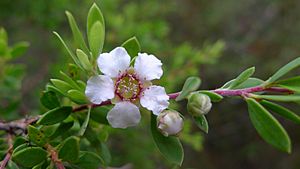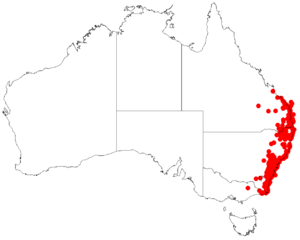Flaky-barked tea-tree facts for kids
Quick facts for kids Flaky-barked tea-tree |
|
|---|---|
 |
|
| A Flaky-barked Tea-tree flower in Royal National Park. | |
| Scientific classification | |
| Genus: |
Leptospermum
|
| Species: |
trinervium
|
 |
|
| Where this plant grows in Australia (from AVH) | |
The Flaky-barked Tea-tree, also known as Leptospermum trinervium, is a special kind of shrub or small tree. You can find it only in eastern Australia. It gets its name from its bark, which peels off in thin, papery layers. This tree has white flowers, narrow leaves, and fuzzy fruits that drop off when they are ready. Other common names for it include slender tea-tree or paperbark tree.
Contents
What Does the Flaky-barked Tea-tree Look Like?
The Flaky-barked Tea-tree is usually a shrub or a small tree. It can grow to be about 2 to 6 meters (6.5 to 20 feet) tall. Its bark is very unique, peeling off in thin, paper-like strips.
Leaves and Flowers
The leaves of this tea-tree are narrow and shaped like an egg, wider at one end. They are about 9 to 22 millimeters (0.35 to 0.87 inches) long and 1 to 6 millimeters (0.04 to 0.24 inches) wide. The tip of the leaf is usually rounded, and the base narrows down to a short stem called a petiole.
The flowers are white and about 7 to 15 millimeters (0.28 to 0.59 inches) wide. They grow alone or in pairs at the ends of short side branches. The base of the flower, called the floral cup, is covered in soft, silky hairs. It is about 3 millimeters (0.12 inches) long. The sepals, which are small leaf-like parts protecting the flower bud, are also hairy. There are five petals, each about 5 to 7 millimeters (0.20 to 0.28 inches) long. Inside the flower, the stamens (which produce pollen) are about 1.5 to 2 millimeters (0.06 to 0.08 inches) long.
When Does it Flower?
This tea-tree usually flowers from September to October if it's growing near the coast. If it's in higher areas called tablelands, it flowers later, from November to December.
Fruits
After flowering, the plant produces a fruit called a capsule. This capsule is about 3 to 6 millimeters (0.12 to 0.24 inches) wide. It still has the remains of the sepals attached. When the fruit is mature, it falls off the plant.
How Was This Tea-tree Named?
This special tea-tree was first described in 1790 by a scientist named James Edward Smith. He first gave it the name Melaleuca ? trinervia. He wrote about it in a book called Journal of a Voyage to New South Wales, which was written by John White.
Where Does the Flaky-barked Tea-tree Grow?
The Flaky-barked Tea-tree mostly grows in forests. However, you can also find it in areas with heath (low-growing shrubs) and scrubland, especially where there are sandstone rocks. It grows along the coast and in the tablelands. You can find it from Rockhampton in Queensland, through eastern New South Wales, all the way down to the far eastern parts of Victoria.
Can You Grow It in a Garden?
The Leptospermum trinervium is a tough plant, even though it might not be the showiest. Its most interesting part is definitely its papery bark. You can grow new plants from seeds or from cuttings (small pieces of the plant). It can also handle frost, which means it can survive cold temperatures.

